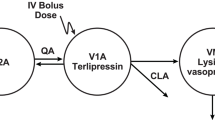Summary
The aim of this study was to investigate the pharmacokinetic and pharmacodynamic properties of irbesartan in renal hypertensive dogs under non-steady-state and steady-state conditions using pharmacokinetic-pharrnacodynamic(PK/PD) modeling. Drugs were administered intragastrically to renal hypertensive dogs, plasma drug concentration was determined by HPLC method and Pharmacologic effects, including SBP, DBP, dp/dtmax and LVSP, were measured simultaneously. AT II, Aldosterone (ALD) and Endothelin (ET) were also used as measurement of effect. The PK and PD data were quantitatively analyzed according to the PK/PD model theory. The pharmacokinetic profiles of irbesartan conformed to a two-compartment open model. There was hysteresis loops between effects and plasma concentrations under non-steady-state condition. The relationship between effects and effect compartment concentrations (Ce) could be represented by the Sigmoid-Emax model. The Hysteresis loops disappeared under steady-state condition with more rapidly attainment of maximum concentration and effect. There were certain difference of pharmacokinetic and pharmacodynamic properties between non-steady-state and steady-state condition.
Similar content being viewed by others
References
Bernard Waeber. (2001): A review of irbesartan in antihypertensive therapy: comparison with other antihypertensive agents. Current Therapeutic Research, 62, 505–521
Hartmut Derendorf, Bernd Meibohm. (1999): Modeling of Pharmacokinetic/Pharmacodynamic(PK/PD) Relationships: Concepts and Perspectives. Pharmaceutical Research, 16, 176–177
XU Shuyun, BIAN Rulian, CHEN Xiu. (2002): The Methodology of Pharmacological Experiment (Third edition) Beijing: People's Sanitation Press, 950–951
Collum WA. (1981): Simultaneous pharmacokinetics and pharmacodynamics modeling, J Pharmacokinet Biopharm, 9, 367–388
5.YIN Xiao-xing, ZHANG Yin-di, LUO Jian-ping. (1997): Pharmacokinetic pharmacodynamic modeling of metoprolol stereoisomers in spontaneously hypertensive rat. Acta pharmacological Sinica, 18, 104–108
Meibohm B, Derendorf H. (1997): Basic concepts of pharmacokinetic/pharmacodynamic(PK/PD) Modelling. Int J Clin Pharmacol Ther, 35, 401–413
CHEN Zhi-yang, ZHENG Qing-shan, SUN Rui-yuan. (2002): Introduction to the main functions of DAS pharmacological software. Chinese Journal of Clinical Pharmacology andTherapeutics, 7, 562–564
Greathouse M (2002): A review of olmesartan medoxomil monotherapy: antihypertensive efficacy similar to that of other angiotensin II receptor blocker/hydrochlorothiazide combinations? Congest Heart Fail, 8, 313–320
Rosenstock J, Rossi L, Lin CS, MacNeil D, Osbakken M (1998): The effects of irbesartan added to hydrochlorothiazide for the treatment of hypertension in patients non-responsive to hydrochlorothiazide alone. J Clin Pharm Ther, 23, 433–440
Mancia G. Clinical differences among angiotensin II receptor antagonists (2001): Blood Press Suppl, 2, 19–24
SHI Shao-Jun, CHEN Hui, GU Shi-Fen, ZENG Fan-Dian (2003): Pharmacokinetic pharmacodynamic modeling of daurisoline and dauricine in beagle dogs. Acta pharmacological Sinica, 24, 1011–1015
Fuseau EΘ§Sheiner LB. (1984): Commentary: simultaneous modeling of pharmacokinetics and pharmacodynamics with a nonparametric pharmacodynamic model. Clin Pharmacol Ther, 35, 733–741
Author information
Authors and Affiliations
Rights and permissions
About this article
Cite this article
Huang, XH., Qiu, FR., Xie, HT. et al. Pharmacokinetic and pharmacodynamic of irbesartan in renal hypertensive dogs under non-steady-state and steady-state conditions. Eur. J. Drug Metab. Pharmacokinet. 30, 121–126 (2005). https://doi.org/10.1007/BF03226417
Received:
Issue Date:
DOI: https://doi.org/10.1007/BF03226417




